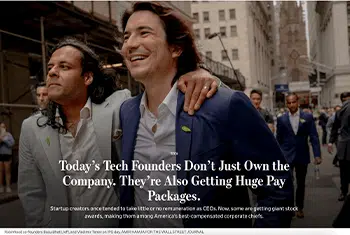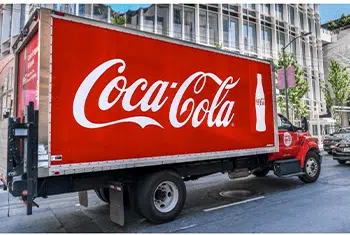Within the next five years, major corporations from JPMorgan Chase to The Walt Disney Co. could be placed under new leadership as their current chief executives eye their exits. Overall, more than one in 10 CEOs at S&P 500 firms have already hit the traditional retirement age. And another nearly 15% could reach age 65… Continue reading Hanging Around: More 65+ CEOs Stay On the Job
Tag: CEOs
Boards Looking for ‘Soft Skills’ in New Crop of CEOs
On Jan. 1, several of the nation’s biggest companies — including Morgan Stanley, Kraft Heinz, Sherwin Williams and Costco — welcomed new CEOs. In all, new chiefs took over at a dozen S&P 500 companies on New Year’s Day, according to data from public company intelligence provider MyLogIQ. A handful of new CEOs will start… Continue reading Boards Looking for ‘Soft Skills’ in New Crop of CEOs
Today’s Tech Founders Don’t Just Own the Company. They’re Also Getting Huge Pay Packages.
Archer Aviation Inc. is years from producing its only planned product, a four-passenger electric air taxi that the main U.S. regulator hasn’t yet certified. It hasn’t generated any revenue.
Still, the co-founders of this three-year-old company got a huge payday last month, a $99 million special stock award that stands to quadruple if Archer hits other milestones—thanks to a compensation package they negotiated before it listed publicly on Sept. 17.
For years, Silicon Valley was known as a place where leaders often bucked American corporate customs when it came to pay. Rather than receiving large stock grants and salaries, company founders like Facebook Inc.’s Mark Zuckerberg and Amazon. com Inc.’s Jeff Bezos took little or nothing. Instead, they benefited from the rising value of stock they got by starting their companies.
…Seven of the 10 most valuable compensation packages for U.S. public companies in 2020 were to CEOs of startups that listed publicly that year, according to public-company data-and-analysis firm MyLogIQ LLC. Five of those startups paid their CEOs more than any company in the S&P 500, an index that includes the largest corporations in the country.
Jet Perks Decline in a Year Marked by Travel Lockdowns
Jet perquisite spending reached a three-year low last year as top employees sheltered in place due to the Covid-19 pandemic. S&P 500 companies spent $93,071 on average per company on jet perks for top executives in 2020, down from $116,805 in 2019 and $115,729 in 2018, according to data from public company intelligence provider MyLogIQ.
“Companies took the tack of traveling less due to the personal health risk that might be involved in sending employees all over the world, but worker compensation and reputational risk also played into the decision to curtail jet use,” said Erik Nelson, director of executive compensation at Willis Towers Watson.
However, some companies opted to use corporate aircraft more frequently to fly executives to business-critical meetings while others extended corporate jet use permissions to directors and executives who didn’t previously have access for safety reasons, filings show. Other companies prohibited personal use of the corporate jet in 2020, opting to save trips for business purposes only.
Sources said the pandemic opened the door for compensation committees to reevaluate the need for corporate jet travel — how often and who uses the jet and how much the board should allow executives to spend on personal and business flights using the company’s aircraft.
The Largest Executive Cash Payments of 2020
Last year was an unusual one for executive pay as the impact of the Covid-19 pandemic upended boards’ best-laid plans.
Many companies publicized decisions to cut executive salaries to show solidarity with laid-off or furloughed employees, while others converted cash payments to equity to preserve liquidity. Year over year, average cash compensation for S&P 500 execs was down 2%, according to data from public company intelligence provider MyLogIQ.
But not for everyone. In some cases, the turmoil wrought by Covid resulted in large cash payments to executives in the form of severance pay, conversions from equity to cash, retention bonuses and other comp vehicles. While many boards may have expected compensation practices to return to normal for 2021, it’s unclear whether the pandemic has truly subsided; the need to tap into otherwise unusual pay methods may not be in the rearview mirror yet.
30 CEOs Who Made At Least 400 Times Higher Than the Median Employee Compensation in 2020
The U.S. Securities and Exchange Commission has long required public corporations to disclose the compensation of their top officers. The debate about whether chief executive officers are paid too much has gone on for decades. Many investors object to high CEO pay, which often runs into the tens of millions of dollars. Boards of directors claim that good CEOs are hard to find and that they have responsibilities for tens of thousands or even hundreds of thousands of workers.
Last year, the CEO of McDonald’s, Christopher Kempczinski, made 1,189 times the median compensation of his workers, according to an exclusive analysis of the pay of 294 public company CEOs done by MyLogIQ, which uses artificial intelligence and machine learning to examine SEC data. Kempczinski’s total pay was $10,847,032 in 2020. The company’s proxy stated, “McDonald’s is committed to a strong pay-for-performance culture that closely aligns the interests of executives with those of shareholders.”
CEO Pay Increasingly Tied to Diversity Goals
The killing of George Floyd in police custody a year ago and the subsequent protests prompted pledges from U.S. business leaders: They would fight racism and work to recruit and promote Black and other minority employees.
Now, more companies are putting money behind those pledges by tying executive compensation to specific goals.
In January, Starbucks Corp. said it would give top executives more shares if the coffee chain’s managerial ranks grow more diverse over three years. McDonald’s Corp. in February gave executives annual incentives to increase the share of women and racial minorities in leadership roles by 2025. In March, Nike Inc. said it would for the first time tie some executive pay to five-year goals for improving racial and gender diversity in its workforce and leadership positions.
From Tesla to GE, See How Much CEOs Made in 2020
Median pay reached $13.4 million for chief executives of the biggest U.S. companies in 2020, setting a fifth straight annual record in a year when businesses and their leaders battled a global pandemic.
Most S&P 500 CEOs got raises of about 5% or more as their companies recorded annual shareholder returns of about 8%, according to a Wall Street Journal analysis of data from MyLogIQ.
See below for the CEOs who made the most and the least, as well as those whose companies delivered the best and worst returns for shareholders. Go to the bottom to explore a table with compensation data on more than 400 CEOs.




